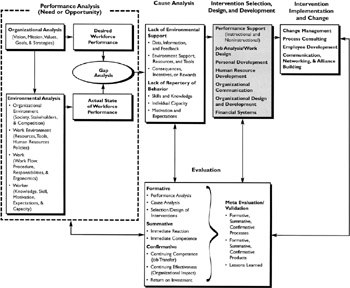Chapter 5: Intervention Selection and Design
Introduction to Intervention Selection and Design
The organizational scan of your performance environment is completed. The conditions, circumstances, and influences of the performance outcome have been considered . The intra- and interworkings of the organization have been meticulously studied. The performance environment and the gap between actual and optimal performance have been analyzed . An extensive cause analysis has been generated. The next phase of the HPT Model ”Intervention Selection and Design ”will help to address performance concerns (see Figure 5-1).

Figure 5-1: HPT MODEL ” INTERVENTION SELECTION AND DESIGN PHASE
Definition and Scope
Interventions are deliberate , conscious acts that facilitate change in performance. Rothwell sees interventions as change efforts that are long- term , evolutionary, and progressive. [1] A well-known consulting agency sees them as "conscious planned actions designed to affect human performance." [2] Interventions are targeted to organizations, departments, work groups, and individuals. The late Clay Carr defined interventions as "the kinds of things you can do to bring about changes in job performance." [3] However they are defined, they run the gamut from large-scale organizational change efforts that affect entire organizational systems at local, national, and global levels to modest ergonomic efforts that provide comfort from Repetitive Stress Syndrome. Even job aids, which remind , aid, or assist workers to evaluate and do work, are unique kinds of interventions (see Table 5-1).
| Performance Support
Job Analysis/Work Design
Personal Development
| Human Resource Development
Organizational Communication
Organizational Design and Development
Financial Systems
Other Interventions |
| Developed by Darlene Van Tiem, James Moseley, and Joan Dessinger. | |
| Sources: Gayeski, Hutchinson and Stein, Stolovitch and Keeps, Hale, and Whiteside and Langdon. | |
Potential Problems With Interventions
The PT practitioner must select the interventions that work best according to the problems identified. The interventions selected will flow smoothly from detailed performance and cause analyses. The practitioner's repertoire should include basic instructional and noninstructional interventions. Although practitioners are not expected to be experts in all categories and subcategories of interventions, they are expected to know where to locate information about interventions. The PT practitioner needs to be able to communicate to all constituents a basic knowledge and understanding of a variety of interventions, especially those in the areas of training, human resources, finances, marketing, organizational design, labor relations, etc.
Successful Interventions
Spitzer lists the following criteria for successful interventions.
-
Design should be based on a comprehensive understanding of the situation. This is where previous performance and cause analyses come together.
-
Interventions should be carefully targeted. Target the right people, in the right setting, and at the right time.
-
An intervention should have a sponsor. A sponsor is someone who will champion the activity.
-
Interventions should be designed with a team approach. The ability to draw upon expertise from all areas of the organization is vital to successful intervention selection.
-
Intervention design should be cost-sensitive.
-
Interventions should be designed on the basis of comprehensive, prioritized requirements, based on what is most important to both the individual and the organization.
-
A variety of intervention options should be investigated because the creation of a new intervention can be costly.
-
Interventions should be sufficiently powerful. Consider long-term versus short-term effectiveness. Use multiple strategies to effect change.
-
Interventions should be sustainable. Thought must be given to institutionalizing the intervention over time. To really be successful, the intervention must become ingrained in the organization's culture.
-
Interventions should be designed with viability of development and implementation in mind. An intervention needs human resources and organizational support.
-
Interventions should be designed using an iterative approach. This occurs during the formative evaluation stage (discussed under the evaluation component of the HPT Model) when multiple revisions will generate interventions to fit the organization. [4] , [5]
Practical Guidelines
This section outlines suggestions based on actual consulting experiences.
-
Conduct thorough performance and cause analyses before considering interventions.
-
Remain focused on a solution for performance problems rather than on a specific intervention.
-
An intervention applied to one performance setting may not work in another setting.
-
Think outside the box. Consider noninstructional interventions too, especially those which are less frequently used.
-
Performance problems have many solutions as well as appropriate and timely interventions to address them.
-
Consider using two or more interventions to address a performance problem.
-
Establish an appropriate set of criteria for evaluating interventions. Justify the use of particular interventions in a variety of settings. An evaluation of the interventions should be ongoing to determine their appropriateness (see chapters on performance and cause analysis).
Subsequent sections will provide an overview of intervention categories, case studies, and job aids. Job Aid 5-1 will aid in selecting an intervention.
| |
Based on the cause analysis and performance gap analysis, select interventions that would improve the situation. Place a check next to each intervention to be considered. Prioritize the possibilities and circle three interventions to begin the performance improvement effort.
| Performance Support
Job Analysis/Work Design
Personal Development
| Human Resource Development
Organizational Communication
Organizational Design and Development
Financial Systems
Other Interventions |
| Developed by Dorlene Van Tiem, James Moseley, and Joan Dessinger | |
| Sources: Goyeski, Hutchinson and Stein, Stolovitch and Keeps, Hale, and Whiteside and Langdon. | |
ISPI 2000 Permission granted for unlimited duplication for noncommercial use.
| |
[1] Rothwell, 1996a, p. 79
[2] Hale Associates, 1993, p. 1
[3] Carr, 1994, p. 65
[4] Spitzer, 1992
[5] Spitzer, 1999, pp. 173 “180.
EAN: 2147483647
Pages: 98